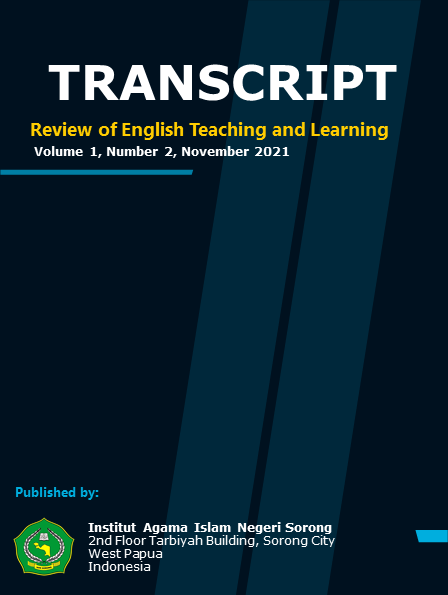External and Internal Factors Triggering Speaking Anxiety in An English Class in West Papua, Indonesia
Keywords:
Anxiety Factors, Internal and External, Speaking English, English Foreign LanguageAbstract
Speaking is one of the four basic skills of English (listening, writing, reading and speaking) and is considered important because in learning English, the goal of students is of course to be able to speak and communicate with each other. However, speaking is an aspect that worries many students, and speaking skills are often used as a benchmark for success in learning English. Students who are certainly anxious will find it difficult to follow the learning process. They may learn less and may not understand what they have learned.
References
Aghajani, M, and H Amanzadeh. “The Effect of Anxiety on Speaking Ability: An Experimental Study on EFL Learners.” Journal of Applied Linguistics and Language Research 4, no. 7 (2017): 154–64. http://www.jallr.com/index.php/JALLR/article/viewFile/690/pdf690.
Aghajani, Mojtaba, and Hanieh Amanzadeh. “The Effect of Anxiety on Speaking Ability: An Experimental Study on EFL Learners.” Journal of Applied Linguistics and Language Research 4, no. 7 (2017): 154–64.
Azwar, Saifuddin. “Metode Penelitian, Edisi I.” Pustaka Pelajar, Yogyakarta, 2007.
Baldwin, Caroline. “How to Overcome Shyness during an Oral Presentation.” Online): Http://Www. Ehow. Com/How-Overcome-Shyness-during-Oral-Presentation. Html, 2011.
Basic, Lejla. “Speaking Anxiety: An Obstacle to Second Language Learning?,” 2011.
Brown, H Douglas. Principles of Language Learning and Teaching. Vol. 4. Longman New York, 2000.
Cubukcu, Feryal. “Foreign Language Anxiety.” Iranian Journal of Language Studies 1, no. 2 (2007): 133–42.
Fatma, Anne, and Sri Ernawati. “Pendekatan Perilaku Kognitif Dalam Pelatihan Berbicara Di Depan Umum” I, no. 1 (2012): 39–65.
Harmer, Jeremy. “The Practice of English Language Teaching.” London/New York, 2001, 401–5.
Horwitz, Elaine K, Michael B Horwitz, and Joann Cope. “Foreign Language Classroom Anxiety.” The Modern Language Journal 70, no. 2 (1986): 125–32.
Kartono, Kartini, and Jenny Andari. Hygiene Mental Dan Kesehatan Mental Dalam Islam. Bandung: Mandar Maju, 1989.
Kessler, Greg. “Fluency and Anxiety in Self-Access Speaking Tasks: The Influence of Environment.” Computer Assisted Language Learning 23, no. 4 (2010): 361–75.
———. “Fluency and Anxiety in Self-Access Speaking Tasks: The Influence of Environment.” Computer Assisted Language Learning 23, no. 4 (2010): 361–75. https://doi.org/10.1080/09588221.2010.512551.
Liu, Meihua. “Anxiety in Oral English Classrooms: A Case Study in China.” Indonesian Journal of English Language Teaching 3, no. 1 (2007): 119–37. http://ojs.atmajaya.ac.id/index.php/ijelt/article/view/132.
Meihua, Liu. “Anxiety In Oral English Classrooms: A Case Study In China.” Indonesian Journal of English Language Teaching 3, no. 1 (2007): 119–21.
Melouah, Asma. “Foreign Language Anxiety in EFL Speaking Classrooms: A Case Study of First-Year LMD Students of English at Saad Dahlab University of Blida, Algeria.” Arab World English Journal 4, no. 1 (2013).
———. “Foreign Language Anxiety in EFL Speaking Classrooms: A Case Study of First-Year LMD Students of English at Saad Dahlab University of Blida, Algeria.” AWEJ Volume4 Number 1, no. 1 (2013): 64–76. www.awej.org.
Musthachim, Anggiana. “Student’ Anxiety In Learning English (A Case Study at the 8th Grade of SMPN 9 South Tangerang).” Thesis, 2014, 1–74.
Nevid, Jeffrey S, Spencer A Rathus, and Beverly Greene. Psikologi Abnormal. Jakarta: Erlangga, 2005.
Nunan, David. Second Language Teaching & Learning. ERIC, 1999.
Öztürk, Gökhan, and Deniz Saydam. “Anxiety and Self-Efficacy in Foreign Language Writing: The Case in Turkey Yabancı Dilde Yazmada Özyeterlik ve Kaygı: Türkiye’de Bir Durum Çalışması.” Başkent University Journal of Education 2014, no. 2 (2014): 10–21.
Downloads
Published
How to Cite
Issue
Section
License
Copyright (c) 2022 Transcript: Review of English Teaching and Learning

This work is licensed under a Creative Commons Attribution 4.0 International License.
As a journal writer, you have the right to various uses of your article, including use by the institution or company where you work. This copyright can be used without special permission.
Publishing authors in TRANSCRIPT: Review of Teaching and Learning English have broad rights to use their work for teaching and scientific purposes without the need to seek permission, including use for classroom teaching by Author or Author institutions and presentations at meetings or conferences and distributing copies to participants; used for internal training by the author's company; distribution to colleagues for their research use; used in compilations of the authors' subsequent works; included in a thesis or dissertation; reuse of sections or excerpts from articles in other works (with full acknowledgement of the final article); preparation of derivative works (other than commercial purposes) (with full acknowledgement of the final article); Voluntary posting on open websites operated by authors or authors' bodies for scientific purposes (follow CC by 4.0 license  ).
).
Authors and readers can copy and redistribute the material in any media or format, as well as remix, modify and build the material for any purpose, even commercially, but they must provide appropriate credit (cite the article or content), provide a link to the license, and indicate if anything changes. If you mix, modify, or build upon the materials, you must distribute your contributions under the same license as the originals.







